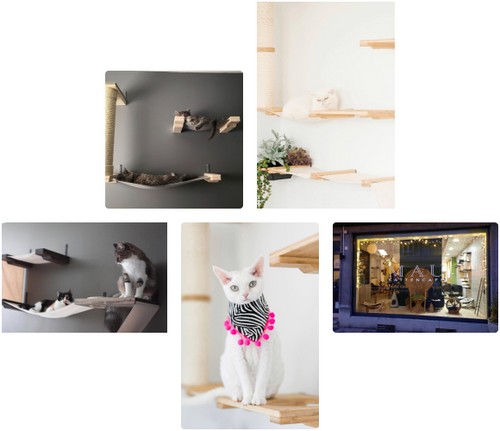As we learn more about cats, we are starting to appreciate how truly intelligent they are. They, and their larger feline relatives, are able to solve complex puzzles, learn through observation of others, and master simple tricks with ease. As more of us dive into training cats, it’s really helpful to understand some of the science around learning and behavior. The benefits or fallout (behavior/stress side effects) of using certain training methods can have a huge impact on the wellbeing of your cat, your relationship with your cat, and even how you understand your cat’s behavior.
Animals learn in many ways. Two important ones are learning through consequence and learning through association.
Learning Through Consequences
All animals learn through consequence. This is a driving rule that allows animals to adjust to a changing world. Learning through consequences comes in four main categories which are detailed below:

These first two methods can be used creatively to both increase or decrease behaviors. They have low behavior/stress side effects, or fallout, and generally increase fond feelings and build relationships.
1. Positive Reinforcement

Adding something pleasant that strengthens a behavior is called positive reinforcement.
Example: Giving your a cat a treat after they sit.
2. Negative Punishment
Taking away something pleasant that weakens a behavior is called negative punishment.
Example: Your cat bats or bites you for attention and you then go into another room.

Those first two methods can be used creatively to both increase or decrease behaviors. They have low behavior/stress side effects, or fallout, and generally increase fond feelings and build relationships.
There are two more categories that use things that a cat doesn't like to change behavior. These categories are avoided by trainers as with each use the risk goes up for unwanted behavioral side effects.
3. Positive Punishment

Adding something unpleasant to weaken a behavior is called positive punishment.
Example: A cat jumps on counter and then you spritz the cat with water.
4. Negative Reinforcement
Removing something unpleasant to strengthen a behavior is called negative reinforcement.
Example: Your cat jumps on your keyboard and you blow air at your cat’s face until your cat hops off.
This is the interesting aspect of using anything a cat would choose to avoid: there is fallout you cannot control. This is because learning through consequence and learning through association happen at the same time.
With the last two options there is a high probability your cat will associate the unpleasant thing with you and not the behavior (for example, the cat will run away when you reach for water in any scenario).
This is where associative learning plays a role.
Learning Through Association
This second major type of learning takes place when the brain simply takes note of what predicted something in time. An example might be getting pulled over by the police and earning a ticket for speeding. After that incident you continue having some anxiety every time you see a police car in your rearview mirror. The ticket was positive punishment, it reduced your behavior of speeding and the fallout is, you now have anxiety when you see any police vehicle now. That was not the intended effect, the police just wanted safer speeds on the road. In the same way cats will associate us with the use of even mild punishments.
Understanding Behavioral Fallout
There are several common types of fallout. In cats, you may see escape, avoidance, aggression, generalization, depression, behavioral suppression, and physical injury. Plus the person using the unpleasant experiences to train will become dependent on using punishment.
1. Escape and Avoidance

An example is when you have used a spray bottle to stop scratching and the cat begins to avoid rooms where you reside, the rooms in which the situation occurred, and other factors, such as the time of day when it occurred.
2. Aggression

Being punished frequently can lead to aggression. Such as when you yell at two cats that are getting into a fight, it can increase the level of aggression towards the other cat or even you.
3. Generalization
A cat can make a wide assumption about what predicts an unpleasant experience. Reaching for a spray bottle causes a cat to turn and run but also reaching for a remote causes them to run because they think you're reaching for a spray bottle.

4. Depression

Having behavior punished frequently can start to reduce behavior overall. If a cat's behavior is constantly evoking punishment they will try less and generally move less.
5. Behavioral Suppression
When a natural behavior like jumping or scratching gets suppressed, and the cat no longer has a natural outlet for the species’ behavioral need , it can lead to even more behavioral problems or health issues.

6. Injury

Frequent punishments can stress cats out. A cat who is panicked from being punished can run into something or fall off something when startled. Cats can also increase fighting as stress increases, overgrooming or other medical fallout can result from increased stress.
7. Reinforcement of the Person
This is a tricky thing, the person who uses the unpleasant experience to train gets reinforced through negative reinforcement. The person makes the annoying or bad situation for themselves go away by using the spray bottle. It is very easy to escalate the use of punishment, and the person begins to rely on its use to control the cat’s unwanted behavior which can cause the cat more stress, leading to more behavioral problems.

Understanding how cats learn can have a huge impact on their welfare and our relationships with them. In life, behavior is punished through unpleasant consequences and also reinforced though pleasant ones every day. The key is to control these unpleasant and pleasant experiences in training to minimize the behavioral fallout.

Increasing pleasant experiences in life promotes animal welfare and reduces aggression, depression, and avoidance. A great side effect of associative learning is that, it will also build pleasant associations with anyone around when good things are happening. All behavior issues can be addressed through more than one training avenue. Understanding the consequences associated with different training paths can allow you to both adjust your cats behavior and strengthen the bond between you and your feline companion.















